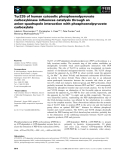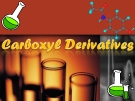
Carboxyl derivatives
-
In simple reaction conditions, the use of DMAP is explored as an easy workup and a green catalyst for the one-pot three-component synthesis ethyl 3-amino-1-aryl-1H-benzo[f]chromene-2-carboxylate derivatives.
 8p
8p  tocectocec
tocectocec
 25-05-2020
25-05-2020
 13
13
 3
3
 Download
Download
-
Tyr235 of GTP-dependent phosphoenolpyruvate (PEP) carboxykinase is a fully invariant residue. The aromatic ring of this residue establishes an energetically favorable weak anion–quadrupole interaction with PEP carboxylate. The role of Tyr235 in catalysis was investigated via kinetic analysis of site-directed mutagenesis-derived variants.
 10p
10p  vinaphone15
vinaphone15
 28-02-2013
28-02-2013
 22
22
 2
2
 Download
Download
-
In organic chemistry, a carbonyl group is a functional group composed of a carbon atom double-bonded to an oxygen atom: C=O. It is common to several classes of organic compounds, as part of many larger functional groups. The term carbonyl can also refer to carbon monoxide as a ligand in an inorganic or organometallic complex. Other organic carbonyls are urea and the carbamates, the derivatives of acyl chlorides chloroformates and phosgene, carbonate esters, thioesters, lactones, lactams, hydroxamates, and isocyanates.
 68p
68p  loc5heo
loc5heo
 07-06-2011
07-06-2011
 122
122
 14
14
 Download
Download
-
IUPAC names: hydrocarbon + “oic acid”. Some natural occurring acids & derivatives. From Grignard reagents. From nitriles: Have 1 more carbon as compared to the halide.
 30p
30p  3dagkhoa
3dagkhoa
 28-10-2010
28-10-2010
 129
129
 38
38
 Download
Download
-
Common names: carboxylic acid - “aldehyde” is substituted for “ic acid”. Lower priority than ester - “oxo” group. Derived names: alkyls + ketone. IUPAC names: hydrocarbon + one.
 42p
42p  3dagkhoa
3dagkhoa
 28-10-2010
28-10-2010
 100
100
 30
30
 Download
Download
-
Carbonylation is one of the most important reactions leading to C-C bond formation. Direct synthesis of carbonyl compounds with CO gives rise to carboxylic acids and their derivatives, such as esters, amides, lactones, lactams etc. The process can be represented by the simple reactions of Scheme 5.1. In general, carbonylation proceeds via activation of a C-H or a C-X bond in the olefins and halides or alcohols, respectively, followed by COinsertion into the metal-carbon bond.
 17p
17p  boyminsk
boyminsk
 10-06-2010
10-06-2010
 121
121
 13
13
 Download
Download
CHỦ ĐỀ BẠN MUỐN TÌM








![Synthesis of ethyl-3-amino-1-aryl-1H-benzo[f]chromeme-2-carboxylate derivatives promoted by DMAP Synthesis of ethyl-3-amino-1-aryl-1H-benzo[f]chromeme-2-carboxylate derivatives promoted by DMAP](https://tailieu.vn/image/document/thumbnail/2020/20200525/tocectocec/135x160/5131590417261.jpg)









